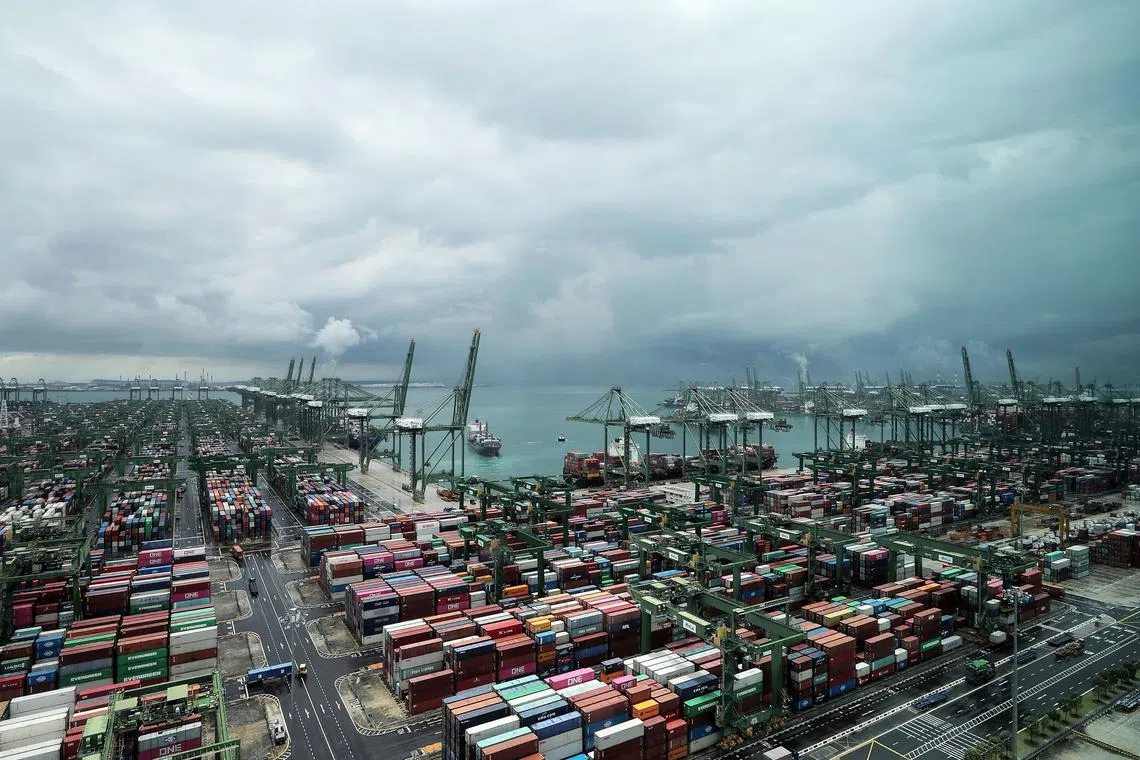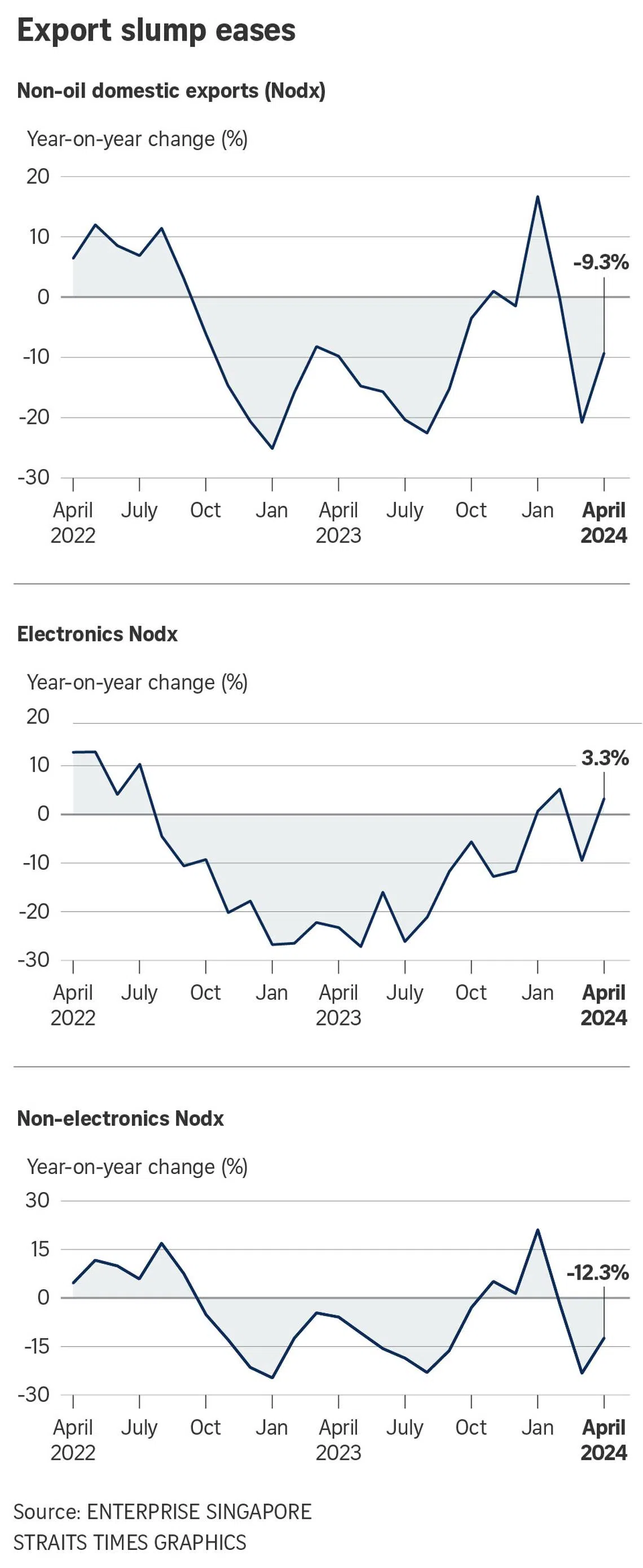S’pore export slump eases to 9.3% drop in April on a turnaround for electronics shipments
Sign up now: Get ST's newsletters delivered to your inbox

Singapore's key electronic exports returned to growth while volatile pharmaceutical shipments continued to shrink.
PHOTO: ST FILE
Follow topic:
SINGAPORE – Singapore’s key exports are on a slow and fragile recovery, as April’s data shows, with most economists hopeful that shipments will improve in the second half of the year.
Non-oil domestic exports (Nodx) fell for a third consecutive month in April but by a milder 9.3 per cent from a year earlier, easing from a revised 20.8 per cent contraction in March.
Trade agency Enterprise Singapore said on May 17 the decline was from a high base as the April 2023 exports figure of $15.4 billion was greater than the monthly average of $14.4 billion for the year.
Notably, electronics exports returned to growth, lending some cheer that underlying end-demand fundamentals remain intact even as volatile pharmaceuticals shipments continued to shrink.
However, Maybank economist Brian Lee noted that while electronics Nodx resumed growth, the key semiconductor segment – which makes up about half of the electronics exports – continued to contract.
April’s Nodx performance was also slightly worse than predicted with economists polled by Bloomberg tipping an 8.9 per cent contraction. On a seasonally adjusted basis, which removes the effects of seasonal variations in the numbers, Nodx grew 7.6 per cent in April from March to reach $14 billion. This was less though than a 9.2 per cent growth expected in the Bloomberg forecast.
Pharmaceuticals exports extended their decline, tumbling 73.3 per cent to $843.8 million in April following a drop of 70.3 per cent in March.
Mr Edward Lee, chief economist at Standard Chartered Bank, said excluding pharmaceuticals, April Nodx would have been up 7.3 per cent year on year.
“April’s headline Nodx continues to indicate a laboured recovery in external demand,” he added.
While there was a pick-up in shipments of electronic products, exports of semiconductors contracted 3.6 per cent, he noted.
Ms Selena Ling, chief economist and head of global markets research and strategy at OCBC, said electronics shipments grew 3.3 per cent year on year after a 9.5 per cent decline in March, potentially suggesting that the March slip was a blip.
Growth in electronics exports was underpinned by personal computers, disk media products and other computer peripherals. All climbed from a low base.
Exports of non-electronic products shrank 12.3 per cent from a year earlier, easing from a 23.2 per cent contraction in March. This was led by pullbacks in pharmaceuticals, non-electric engines and motors as well as food preparations.
Exports to Singapore’s top markets dipped in April, though shipments to mainland China – the Republic’s biggest single market – Malaysia, Hong Kong, Indonesia and Japan advanced. The largest contributors to the contraction were the US, European Union and South Korea.
Exports to the US dropped 40.6 per cent in April, following a 50.2 per cent decline in March. This was led by pharmaceuticals, food preparations and telecommunications equipment.
Singapore’s total trade expanded by 15.7 per cent year on year in April to $109 billion, reversing from a 1.9 per cent decline in March. This was due to a rise in both oil and non-oil trade. Total exports grew 13.3 per cent to $55.9 billion, in contrast to a 3.4 per cent fall in March. Total imports expanded 18.3 per cent to $53.2 billion, after a 0.1 per cent dip in March.

Ms Ling said Singapore’s key exports should gradually improve in the second half of the year on the back of an improvement in electronics and also if China’s growth stabilises.
She added: “At this juncture, the lower end of the official full-year 2024 Nodx forecast of 4 to 6 per cent may appear to be somewhat at risk as the first four months’ Nodx performance is already at weaker-than-expected -4.9 per cent.”
Mr Jester Koh, UOB associate economist, said the bank has downgraded its 2024 Nodx growth forecast to 4.5 per cent, from 6 per cent previously, to reflect the year-to-date performance. But he added that UOB also expects a more meaningful recovery in the second half of the year.
Mr Chua Han Teng, an economist at DBS Bank, said the recovery will be gradual and fragile. “We continue to expect Singapore’s electronics shipments to benefit from the ongoing upturn in the global electronics cycle as demand and inventory normalise after 2023’s significant digestion,” he added.
There are also global uncertainties to monitor, including potential conflicts that could disrupt supply chains, US-China rivalry and US interest rates.
Mr Masahiro Nozaki, an economist at the International Monetary Fund (IMF), said on May 16 that Singapore’s economy is recovering.
Gross domestic product growth is projected to recover to 2.1 per cent in 2024 from 1.1 per cent in 2023, reflecting a continued recovery in manufacturing, tourism and consumer-facing services, he added, following IMF’s annual “health check” on the Singapore economy.
Risks to the growth outlook stem mainly from external factors, such as a steeper-than-projected slowdown in China, prolonged tight US monetary policy and deeper geo-economic fragmentation. On the other hand, stronger global growth would have positive spillovers for the Republic, he added.


